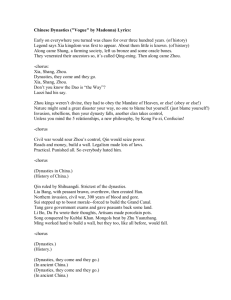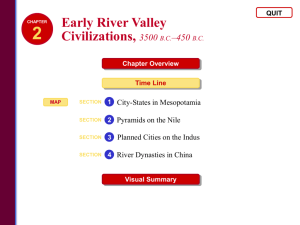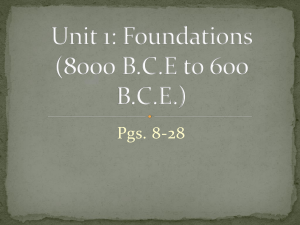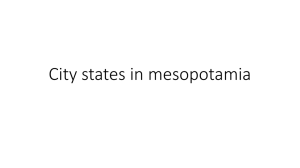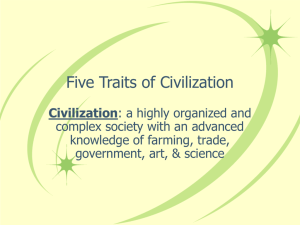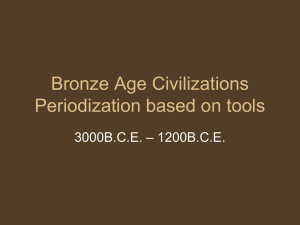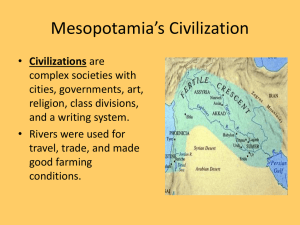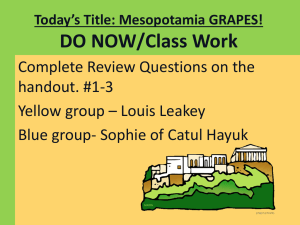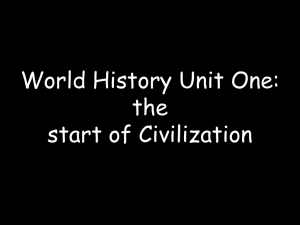Ch. 2 Early Civilizations
advertisement
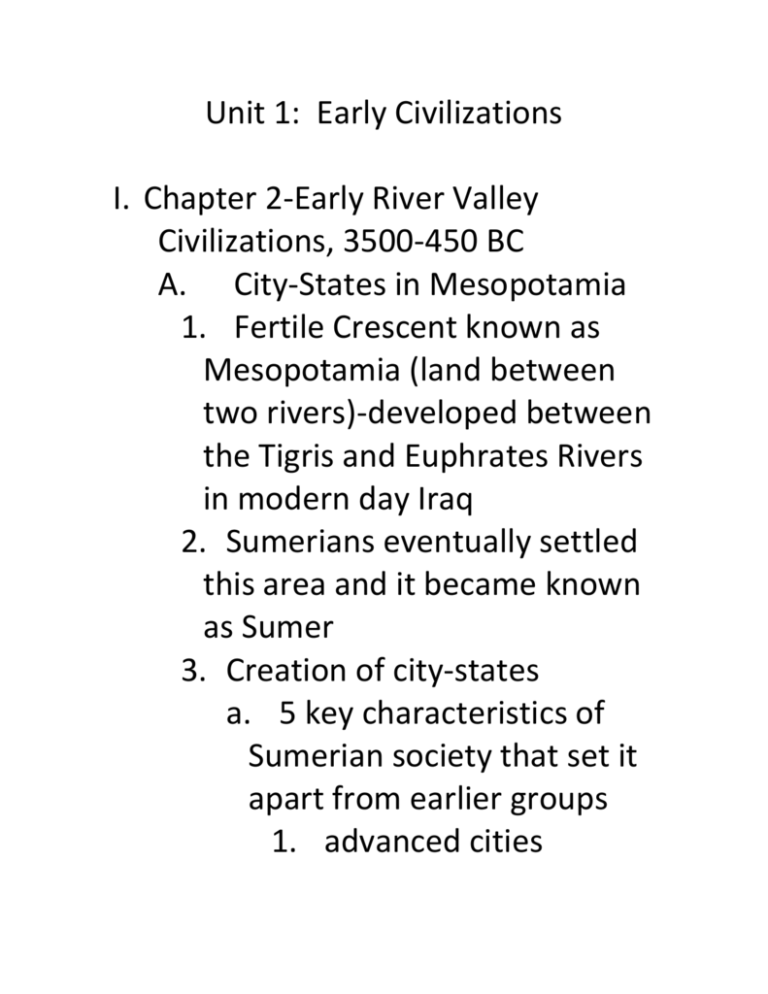
Unit 1: Early Civilizations I. Chapter 2-Early River Valley Civilizations, 3500-450 BC A. City-States in Mesopotamia 1. Fertile Crescent known as Mesopotamia (land between two rivers)-developed between the Tigris and Euphrates Rivers in modern day Iraq 2. Sumerians eventually settled this area and it became known as Sumer 3. Creation of city-states a. 5 key characteristics of Sumerian society that set it apart from earlier groups 1. advanced cities 2. specialized workers 3. complex institutions 4. record keeping 5. improved technology b. 3000 BC-Sumerians built many cities which became city-states 1. each had its own government and its own rulers 2. cities controlled the surrounding land and these became known as city-states 3. earliest governments controlled by temple priests 4. had ziggurats-places of worship and it was like a city hall 5. eventually military leaders became rulers and passed their power onto their sons forming dynasties –after 2500 BC many city-states were under the rule of dynasties c. spread of city-states 1. with the surplus of goods Sumerians were able to increase longdistance trade 2. products and ideas were exchanged with neighboring cultures and this process is called cultural diffusion 5. Sumerian Culture a. polytheism-belief in more than one god b. social classes began to develop along with civilizations 1. kings (representatives of the gods), landholders, priests at top 2. wealthy merchants 3. majority of Sumeriansfield laborers or working in shops 4. lowest level-slaves c. women-could work as merchants, farmers, or artisans; could hold property in their name, join the priesthood, upper class women could learn to read or write *Sumerian women had more rights than women in later civilizations d. inventions-wheel, the sail, the plow, one of first civilizations to use bronze, e. used arithmetic and geometry f. architectural inventionsarches, columns, ramps g. Cuneiform-system of writing 6. Sargon of Akkad-2350 BC-he defeated the city-states of Sumer and created the world’s first empire and his dynasty lasted around 200 years 7. Babylonian Empire-2000 BCnomadic warriors invaded Mesopotamia and established a capital at Babylon a. Hammurabi reigned during the peak of Babylonian Empire from 1792 BC to 1750 BC b. Hammurabi’s Code-set of laws created by Hammurabi which reinforced the principle that government had a responsibility for what occurred in society 8. Assyrians, Phoenicians and Hebrews would eventually adopt many ideas of the Sumerians B. Pyramids on the Nile 1. civilization developed in modern day Egypt on the Nile River 2. Upper and Lower Egypt-King Narmer united Upper and Lower Egypt around 3000 BC 3. 2660 to 2180 BC-period known as the Old Kingdom a. pharaohs were Egyptian godkings 1. rule was based on religious authority called a theocracy 2. pharaohs were the center of religion, government and the army b. pyramids were built as tombs for pharaohs who ruled even after death c. pyramids showed strength of Egyptian civilization both economically and technologically 4. Egyptian culture and life a. polytheistic b. believed in afterlife so all classes prepared for death c. social classes (designed like a pyramid) but were fluid 1. king, queen, royal family 2. upper class-wealthy landowners, government officials, priests and army commanders 3. middle class-merchants and artisans 4. lower class-(largest class) peasant farmers and laborers 5. later in history-slaves d. women-held many of the same rights as men-owning and trading property, proposing marriage or divorce e. hieroglyphics-at first written on stone and clay, then on papyrus f. science and technology 1. developed a calendar to track the Nile’s floods 2. system of written numbers for counting, taxes, etc. 3. mathematical knowledge-geometry and calculations for pyramids 4. medicine-could check a pulse, set broken bones, treat wounds and fevers, and some surgery 5. Invaders a. Old Kingdom ended about 2180 BC b. Middle Kingdom arose to restore law and order (2040-1640 BC) c. Hyksos from Palestine area moved in and ruled from 16301570 BC d. New Kingdom in Egypt eventually arose (1570-1075 BC) C. Planned Cities on the Indus 1. civilization arose c. (circa=around) 2500 BC in modern day Pakistan and India in the Indus River Valley 2. historians know little since they cannot decipher their writing system 3. Harappan civilization-name given to the Indus Valley civilization 4. had sophisticated city planninggrid system, plumbing, sewage systems, and built mud brick walls to protect from flooding which suggests a strong central government D. River Dynasties in China 1. settlements began on and between two rivers on the North China Plain a. Huang He (Yellow River or China’s Sorrow)-loess b. Chang Jiang (Yangtze) 2. because of China’s isolation there was little trade 3. faced numerous invasions from the north and west 4. Huang He-First dynasties developed here before Sumerians in Mesopotamia 5. Shang Dynasty-1700-1027 BCfirst to leave written records a. cities built mainly of wood with earthen walls for protection b. major tool of war-chariot 6. Chinese culture a. main loyalty was to the family and elders, then obedience and respect for the ruler of the Middle Kingdom (China’s name for itself) b. family-central to Chinese society, as was respect for one’s parents 1. elders controlled property and made decisions 2. women-treated as inferiors and were expected to obey their fathers, husbands, and then their sons c. social classes 1. sharply divided between nobles and peasants, ruled by a king 2. ruling class-warriornoble families owned land and governed local villages themselves while paying a tribute to the Shang ruler d. religion 1. believed family ancestors had the power to bring fortune or disaster 2. also consulted the gods through the spirits of their ancestors e. writing 1. each character stood for one syllable or unit of language 2. no link between China’s spoken language and its written language so people in all parts of China could read it which unified large areas 3. numerous written characters- 1,500 to become literate, scholars knew at least 10,000 5. nobles learned to read and write, peasants did not 7. Zhou and the Dynastic Cycle (1027-256 BC) a. Zhou overthrew the Shang in 1027 BC and adopted a lot of the Shang culture b. Mandate of Heaven-the Zhou created this concept saying that a just ruler had divine approval and royal authority came from heaven and kings could lose the Mandate of Heaven and the right to rule c. Mandate of Heaven-the way new dynasties were able to rise and fall in what became known as the dynastic cycle (chart on pg. 54) d. feudalism-the Zhou created this political system in which nobles, or lords, are granted the use of lands that legally belong to the king and then owe loyalty and military service to the king and they protect the people who live on their estates 1. the lords grew stronger as their areas grew in size 2. people gradually accepted the lords’ rule 3. the lords became less dependent on the king and began fighting with themselves and neighbors for wealth and territory e. improvements in technology and trade 1. roads and canals-built for trade and agriculture 2. coined money was introduced-improved trade 3. blast furnaces were made for cast iron production f. warring states 1. Zhou dynasty-mostly peaceful and stable, but rule weakened 2. 771 BC-nomads from the north and west overthrew the Zhou capital and monarch 3. dynastic cycle eventually brings about a new start to Chinese civilization

